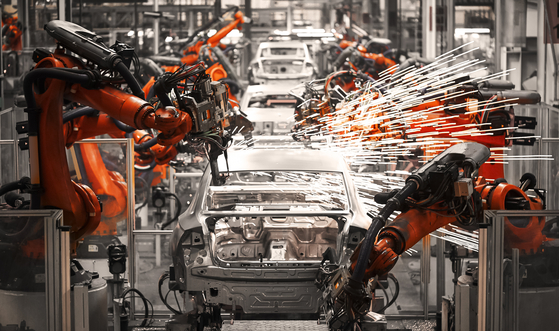Don’t downsize the manufacturing sector

Cho Yoon-je
The author is a professor emeritus at Sogang University and a member of the Monetary Policy Board of the Bank of Korea.
The global economy is taking a drastic turn. In the United States — once the icon of neoliberalism and the leader of globalization — both the Democratic Party and the Republican Party now support government intervention to protect and foster domestic industries. The European Union (EU) prepares to launch the so-called “EU sovereignty fund” to overcome apparent damage from its current ban on discreet industrial policies of member countries to strengthen their own competitiveness. The EU is even poised to endorse its members’ subsidy programs for their key industries to secure a competitive edge over non-EU countries.
The proponents of neoliberalism changed their mind due to a deepening sense of crisis from the dramatic catchup of China in industrial and technological competitiveness, which poses a direct threat to their economic superiority and national security. Seen from a different angle, the abut-turn could translate into the EU’s recognition of the merits of the past industrial policies of East Asia, including Japan, Korea, Taiwan and Singapore, as well as China.
As early starters in the Industrial Revolution, Europe and the United States have long enjoyed their newfound status as manufacturing powerhouses thanks to their dominance in industrial technology and production facilities. It was at the end of the 19th century that Britain handed over its crown to the United States after relishing over a century of prestige. The United States also surrendered its position as the world’s largest manufacturer to China in the early 20th century after ascending to the throne more than a century before. The manufacturing powers then moved on to the tertiary industry — or the knowledge-based services sector such as finance, insurance, distribution, consulting, design, accounting and public relations — to gain the upper hand over the late starters.
Britain and the United States had to shift their focus to the service sector after their manufacturing industries lost competitiveness to Japan and Germany — and then to China and other emerging economies. The share of manufacturing in the GDPs of Britain and the United States once exceeded 40 percent, but plunged to 10 percent and 9 percent, respectively. In the meantime, Germany and Japan — which took the path of industrialization later than Britain and the United States and whose services-sector competitiveness was weaker than the two early starters — still remain manufacturing powers.
Compared to other advanced economies, Korea’s manufacturing sector is declining fast. After reaching 14 percent in 1963 and peaking at 31 percent in 2011, manufacturing’s share of the GDP is estimated to be 27 percent in 2023. The decrease in our manufacturing jobs sounds more alarms. Those workers’ share in the total workforce fell to 16 percent in 2022 after soaring to a high of 28 percent in 1989 from a paltry 8 percent in 1963. After the massive relocation of factories overseas by Korea Inc. to compete with China and other emerging economies in labor costs, the share of the IT sector grew despite its weak impact on hires.
But unfortunately, Korea’s manufacturing industry didn’t have much time to expand further until the knowledge-based service industry could build its own competitiveness. As a result, workers released from the manufacturing industry had to migrate to a form of underemployment at places like restaurants, retailers, the self-employed or daily hires. That helped downsize our middle class and worsened income polarization further, fueling a political conflict among lawmakers and the general public.
Korea must boost the competitiveness of the high-value service industry. But that is only possible when it is backed by the accumulation of experiences and knowledge over the long haul. Therefore, Korea must keep its manufacturing sector to help prevent a further decline of its potential growth. In a nutshell, manufacturing is an indispensable industry for Korea, whose top priority is protecting national security.
The debate over the effectiveness of industrial policy is not over yet due to its double-edged nature. But given underlying factors such as national security and climate action for advanced economies, those countries will maintain or strengthen their own industrial policy.

These days, each country’s race for effective industrial policy prompts the rebuilding of global industry and supply chains. Korea must carefully draw up a national strategy based on a cool judgement of international circumstances. Korea’s conglomerates, already global companies, must have paid closer attention to analyzing external changes and choosing production sites overseas than the government. The government must think again if the accompaniment of corporate leaders to presidential trips overseas to promise their investment in foreign countries will really benefit them. Instead, it will be even better for the government to help them gain an easy access to overseas markets through diplomacy, and domestically, to improve their investment environments by easing regulations on factory sites, the rigid wage system and the two-tiered employment system, as well as innovating its policy for SMEs.
One of the most feasible ways for the government to reduce unwanted side effects — and raise the efficiency — of industrial policy is to focus on investing in R&D and assisting private companies’ effort to foster technology talents rather than simply providing financial support for individual companies. Last but not least, such efforts should be backed by a revamp of our educational system toward providing more scholarships to science and engineering students at colleges and allowing companies to set up their own vocational schools, too.
Translation by the Korea JoongAng Daily staff.










with the Korea JoongAng Daily
To write comments, please log in to one of the accounts.
Standards Board Policy (0/250자)